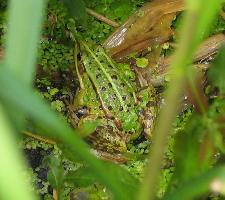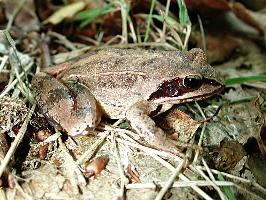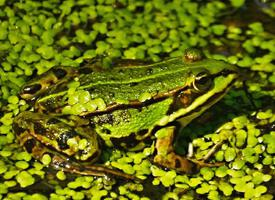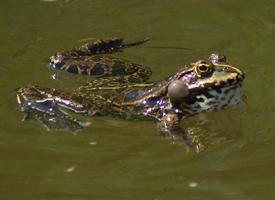
Váhy a míry
| Délka | od 4 do 5 cm |
|---|
Popis zvířete
The Pool Frog (Pelophylax lessonae) is a fascinating amphibian species that is part of the family Ranidae, which encompasses a wide range of true frog species. Known for its distinctive croak and adaptability to various aquatic environments, the Pool Frog has garnered attention from conservationists and herpetologists alike due to its interesting behaviors, habitat preferences, and the challenges it faces in the wild.Physically, the Pool Frog is a medium-sized frog, with adult specimens typically reaching lengths of about 5 to 9 centimeters. They exhibit a range of colors, often displaying a green or brownish back with dark spots scattered across their skin, which helps them camouflage in their natural habitats. A notable feature is the presence of a light stripe running down the middle of the back, which can vary in visibility among individuals. Their bellies are usually lighter, ranging from white to yellowish, and their legs are strong and well-suited for both swimming and jumping.
The Pool Frog's natural habitats are closely tied to freshwater environments. They thrive in a variety of aquatic settings including ponds, lakes, marshes, and slow-moving rivers, showing a particular preference for areas with abundant vegetation both in and around the water. This vegetation is crucial not only for providing the frogs with hiding spots from predators but also for supporting the insects and other small creatures they prey upon.
Diet-wise, Pool Frogs are insectivorous, primarily feeding on a diet of insects, spiders, and other small invertebrates. Their hunting strategy involves waiting patiently for prey to come close before striking with their quick, sticky tongues.
Reproduction in Pool Frogs occurs in water, where after a series of distinctive mating calls, females lay clutches of eggs that adhere to underwater vegetation. These eggs hatch into tadpoles, which undergo a remarkable transformation, metamorphosing into fully formed frogs. This life cycle is closely linked to the quality and health of their aquatic environments, making the preservation of clean water bodies crucial for their survival.
Unfortunately, the Pool Frog faces several threats, including habitat destruction, pollution, and the introduction of invasive species. These factors have led to declines in some of their populations, prompting conservation efforts aimed at protecting their natural habitats and ensuring the species' survival. In some regions, the Pool Frog is protected under various environmental laws and conservation programs, highlighting the importance of these amphibians to the biodiversity of their ecosystems.
In summary, the Pool Frog (Pelophylax lessonae) is an intriguing species that plays a significant role in the health and diversity of freshwater ecosystems. With their distinctive appearance, interesting behaviors, and the challenges they face, Pool Frogs are a symbol of the delicate balance within aquatic habitats and the need for concerted conservation efforts to protect these and other amphibian species.
Podobná zvířata
Nové fotografie zvířat
Top 10 zvířat
- Chinese water dragon (Physignathus cocincinus)
- Galápagos tortoise (Geochelone nigra complex)
- Sea urchins (Echinoidea)
- Diana monkey (Cercopithecus diana)
- Dolphin gull (Leucophaeus scoresbii)
- Moustached guenon (Cercopithecus cephus)
- Japanese macaque (Macaca fuscata)
- Royal penguin (Eudyptes schlegeli)
- Hen harrier (Circus cyaneus)
- Barbary macaque (Macaca sylvanus)


